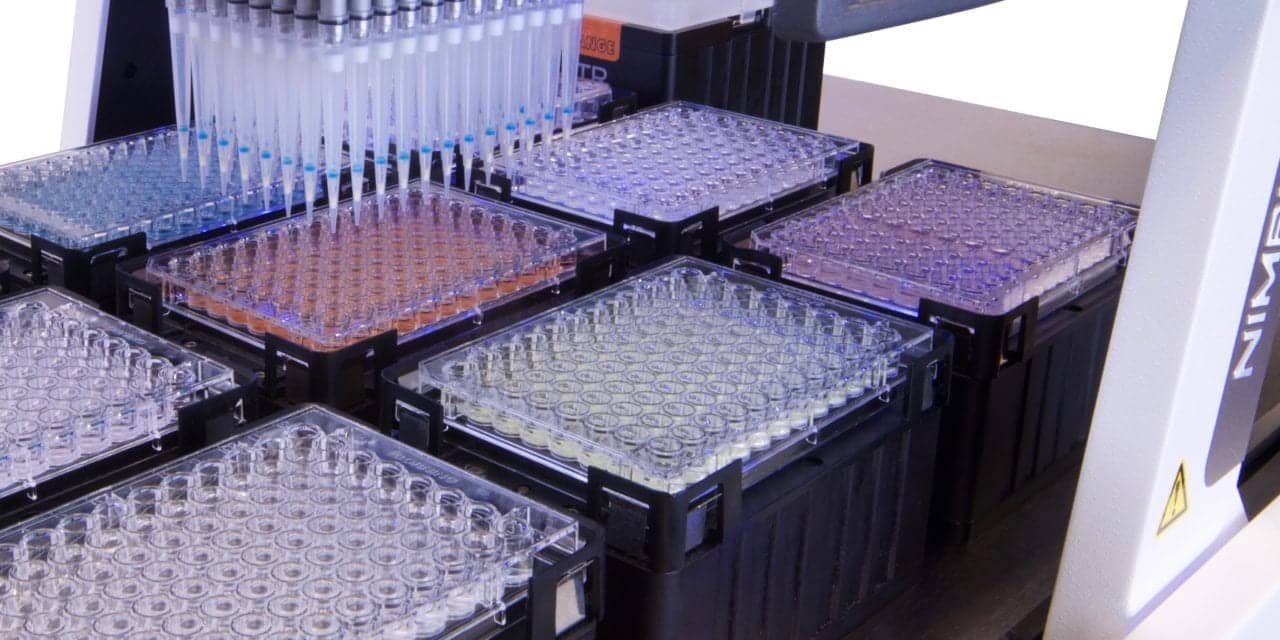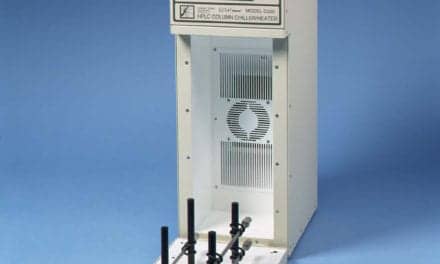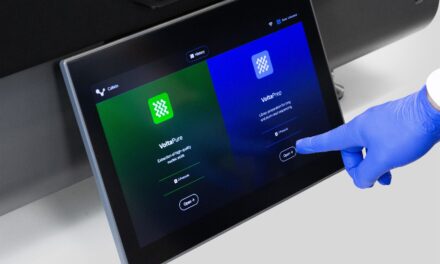By Kevin W.P. Miller, PhD; William E. Kemnitzer, PhD; Nicholas R. Chestara; and Kaylee R. Mastrianni, PhD
When performing mass spectrometry analysis of patient specimens, the workflow of clinical laboratories has traditionally required that complex biological samples be purified prior to analysis. However, the methods used to perform such sample preparation have frequently burdened clinical laboratories with the need for dedicated offline instrumentation to perform preanalytical steps, often also introducing costly reagents and lengthy turnaround times. Added to this burden, operator errors and variability in performing offline sample preparation frequently necessitate sample retesting, further compounding the time and costs related to such procedures.
To meet the demand for greater throughput, many clinical laboratories are moving toward the adoption of automated liquid handlers. But the spectre of burdensome offline procedures remains a concern. Many liquid handling platforms offer limited options for sample preparation, forcing clinical laboratories to consider ‘dilute and shoot’ methods that result in less robust data and increase the need for maintenance and repair of liquid chromatography-mass spectrometry (LC-MS) instruments.
This article discusses a novel automated pipette tip-based technology that increases throughput while reducing the risks of operator error and variability. The technology also eliminates the need for dedicated offline sample preparation equipment, protects analytical instruments from costly downtime, and miniaturizes assays to reduce the use of costly reagents and the potential for waste.
Complexities in Clinical Testing
In clinical settings, patient care decisions often hinge upon the availability of accurate test results produced within a clinically relevant timeframe. However, the process of arriving at such accurate results is frequently complicated by the need to prepare and evaluate complex biological samples—time-consuming steps that can make it difficult to meet required turnaround timeframes.
Manual workflows that involve hands-on sample preparation steps to remove interferents can limit throughput and require laboratorians to perform low-value activities, such as repetitive pipetting. Manual repetitive pipetting exposes operators to discomfort and repetitive strain injuries, while contributing to operator error and performance variability.
The need to manage expenses adds another layer of pressure on clinical labs. Manual sample preparation and processing workflows may require expensive and space-consuming third-party instruments, such as centrifuges and vacuum manifolds. Meanwhile, the cost of assay reagents also represents a significant ongoing expense that labs must manage, especially when a lab’s increasing throughput means that reagents are being used at a quicker rate, reflective of the lab’s growing overall assay volume.
Processing Patient Specimens
Clinical laboratories commonly use one of two methods for mass spectrometry processing of biological samples, including patient specimens. Developed over time in response to laboratories’ need to process many complex specimens as quickly as possible, each of these two methods, described below, suffers from drawbacks that would make them less than optimal if any other alternative were available.
Dilute-and-Shoot Methods.
A dilute-and-shoot method involves dilution of an unpurified sample with an internal standard or other diluent, and direct injection of the sample into the lab’s liquid chromatography-tandem mass spectrometry (LC-MS/MS) instrumentation.
Dilute-and-shoot methods are perceived as being rapid and inexpensive, and often require only a minimal amount of sample preparation prior to injection. However, in the absence of any purification steps, diluted samples can contain interfering lipids, proteins, salts, and other analytes. The resulting matrix effects can enhance or suppress the signal response from the analytes of interest, thus affecting the accuracy and precision of the test.
The generation of erroneous test results can, in turn, increase the frequency of sample retesting, adversely affecting a lab’s turnaround times and overall expenses. Additionally, the undesired impurities in the lab’s samples can reduce the service life of the LC-MS/MS instrument, and increase the need for costly instrument maintenance and repair.
Solid-Phase Extraction Methods.
Sample preparation via solid-phase extraction (SPE) is a preferred method for purifying and concentrating analytes of interest.
In SPE, a liquid biological matrix such as blood (including plasma, serum, or whole blood), oral fluid, or urine suspected of containing the analytes of interest is loaded onto the top of a resin cartridge. Analytes are passed through the cartridge, and become bound to the appropriate solid-phase sorbent to which each has an affinity. Subsequent wash steps reduce matrix effects by removing irrelevant and unbound analytes from the solid-phase material.
The analyte of interest is then eluted from the sorbent with an appropriate organic solvent. Typically, the clean extract is solvent-evaporated for derivatization via gas chromatography-mass spectrometry (GC-MS) analysis, or solvent-evaporated and reconstituted for increased sensitivity (LC-MS/MS) analysis.
In comparison to dilute-and-shoot methods, solid-phase extraction produces cleaner extracts for accurate results without matrix effects, and also protects sensitive instruments from costly and unwanted downtime due to maintenance and repair.
Conversely, SPE requires dedicated equipment and significant hands-on time that also introduces the potential for operator error and performance variability and, therefore, the risk of increased sample retesting. More recently, SPE methods have been implemented on automated liquid handling platforms to increase throughput and decrease operator involvement. But the systems still require additional equipment, including items such as centrifuges and vacuum- or positive-pressure manifolds.
Automated Tip-Based SPE
As an alternative to dilute-and-shoot methods and traditional solid-phase extraction techniques, a novel pipette tip-based sample preparation technology offers an automated workflow that is both rapid and accurate. This patented extraction method incorporates dispersive solid-phase extraction (dSPE) within a specialized pipette tip, thereby minimizing the volume of reagents required and eliminating the need for centrifuges and vacuum- or positive-pressure manifolds.

Figure 1. Anatomy of two tip-based dispersive extraction technologies. The in-tip technology (left) includes an upper porous barrier (a), baffle system (b), polymeric-based sorbent (c), and frit (d). The tip-on-tip technology (right) includes polymeric-based sorbent (c), pressure gasket (e), wide-bore tip (f), and filter (g). Note that the filter tip (h) is modifiable to match the desired matrix.
Compared to traditional SPE, dSPE offers unique advantages, in that it uses loose sorbent that maximizes binding capacity by increasing the exposed surface area. Embedding the loose sorbent in the specialized tip design allows cost-saving miniaturization and customization of the workflow, while the equilibration mechanism provides rapid and robust extraction of the analytes of interest.
The specialized tips are specifically intended for use with automated liquid-handling workstations, and can be routinely used with oral fluid, plasma, serum, urine, whole blood, and solid biological specimens to perform a variety of clinical laboratory and toxicology applications. Automating the process of sample preparation within the pipette tip increases throughput, reduces time to results, eliminates operator errors and performance variability, and enables laboratorians to refocus their attention on high-value activities such as results analysis. The tip-based method also reduces the frequency of retesting, lowers costs by making it possible to reallocate labor and reduce reagent use through miniaturization, and eliminates the need for costly additional equipment.
Two types of tip-based dispersive pipette extraction technologies are available: in-tip and tip-on-tip (Figure 1). Each is dependent on a precise lock-and-key fit between the pipette tip and pipette channel mandrel to facilitate optimal operation.
The in-tip type uses a specialized pipette tip with a lower frit barrier and an upper porous barrier, between which is a freely moving polymeric-based sorbent. When a liquid sample is mixed with solvent and aspirated from a 96-well microplate into the specialized tip, it passes through the frit barrier and contacts the sorbent. The flow of the liquid is disrupted by air drawn into the tip as well as by a baffle system contained within the tip, thereby encouraging turbulent mixing that promotes the binding of the sorbent to analytes of interest, or matrix interferents, through ionic exchange or hydrophobic interactions.
The in-tip technology maximizes the surface area of the sorbent in contact with the sample, and eliminates the risk of sorbent clumping upon contact with the sample. Subsequent washing steps remove any interfering compounds, and the clean extract is then eluted into an assay plate and automatically transferred to the LC-MS/MS system for analysis. (For more information, see “In-Tip Sample Preparation for Catecholamine and Metanephrine Analysis.”)
The tip-on-tip type uses a wide-bore tip to aspirate a solvent and thoroughly mix it with a sample in order to precipitate proteins. The wide-bore tips containing the sample mix are then pressure-fitted inside filter tips, and the solution is dispensed through the filter tips and into an assay plate. The resulting supernatant can be automatically transferred for analysis or further downstream sample processing. Additionally, filter tips containing solid-phase extraction sorbents may be used to enhance sample cleanup. (For more information, see “Comparison of Manual Methods and Automated Tip-on-Tip Methods.”)
Conclusion
For clinical laboratories faced with continual pressures to produce highly accurate test results, achieve rapid turnaround times, and maintain acceptable budget parameters, an automated tip-based dispersive pipette extraction method is an effective alternative to manual dilute-and-shoot and solid-phase extraction methods.
The hands-free automated solution increases sample throughput and enables laboratorians to focus on high-value activities, decreasing overall turnaround times compared to traditional solid-phase extraction methods. The automated workflow also eliminates or reduces the risks and costs associated with operator error and variability. And the purified extracts produced by the tip-based extraction method effectively minimize the need for time-consuming and costly retesting.
The automated tip-based dispersive pipette extraction method eliminates matrix effects, making it possible for laboratorians to attain a high degree of data accuracy. And at the same time, the method extends the duty cycle of a laboratory’s analytical instruments, with minimal downtime required for instrument maintenance.
Kevin W.P. Miller, PhD, is market segment leader for government and regulated laboratories at Hamilton Robotics. William E. Kemnitzer, PhD, is director of US West sales; Nicholas R. Chestara, is a technical sales associate; and Kaylee R. Mastrianni, PhD, is an applications chemist; all three are at DPX Laboratories. For further information, contact CLP chief editor Steve Halasey via [email protected].









